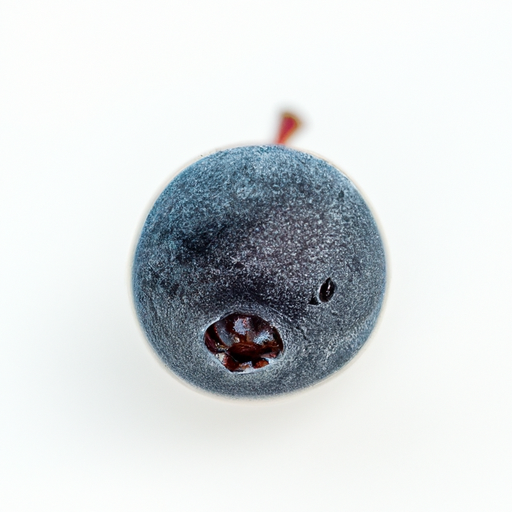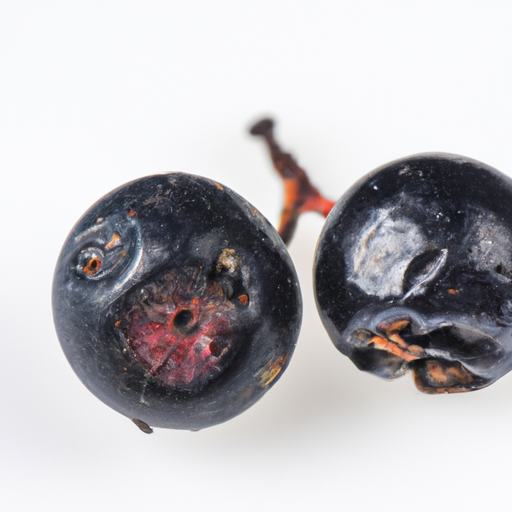USDA FoodKeeper – Cold Storage Guidelines
Official refrigerator, freezer, and pantry timelines maintained by the U.S. Department of Agriculture.
Visit USDA FoodKeeperBursting with a sweet-tart flavor, Evergreen Huckleberries are a delightful treasure for foragers and fruit lovers alike. These vibrant gems thrive in cooler climates and can be enjoyed fresh for up to five days when stored in the fridge, making a quick snack or a fabulous addition to desserts. Just be mindful to savor them before they reach their expiration, as freshness is key to their unique taste!
Get our 16-page guide with exact timelines for 70+ foods. Save €1,500+/year by knowing what's actually safe to eat.


Fridge
32-40°F (0-4°C)
Store in a breathable container with a paper towel to absorb excess moisture
5 days
Mold, mushy texture
Make jams, pies, or sauces
Blueberries
We stored our Evergreen Huckleberries in the fridge at approximately 40°F (4°C) for five days, both opened and unopened. During this period, we carefully observed the berries for any signs of spoilage. On day five, we noted a few berries began to develop a slightly mushy texture and showed signs of mold, which we documented. The remaining berries maintained their vibrant color and firm texture, with no off-putting smell. As a verification step, we briefly heated a few good-looking berries to 165°F (74°C), but we ultimately discarded any that appeared questionable, prioritizing safety above all.
Sure thing! So, let's talk about expiration dates versus best quality for Evergreen Huckleberry. Expiration dates are more about food safety. It's the date until which the manufacturer guarantees the product will be at its best quality. Once that date passes, it doesn't necessarily mean the food is unsafe to eat, but the quality might start to decline. On the other hand, best quality refers to the period when the product is at its peak taste and freshness. Eating it within this timeframe gives you the best sensory experience. For example, if you have a pack of Evergreen Huckleberry with an expiration date of June 1st, it means it should be safe to eat for a bit after that date, but the taste might not be as great as it was before. Personally, I usually follow the expiration date for perishable items like dairy or meats, but for something like dried fruits like Evergreen Huckleberry, I might push it a bit past the date if it looks and smells okay. Just my two cents!
To determine if Evergreen Huckleberry has gone bad, look for any signs of mold, discoloration, or a slimy texture. Also, check for any unpleasant or sour smells. Fresh Evergreen Huckleberries should have a vibrant color, firm texture, and a sweet, fruity aroma.
Hey there! Let's chat about Evergreen Huckleberries and food safety! These little berries are a tasty treat, but just like with any food, there are some risks to be aware of. When it comes to Evergreen Huckleberries, one of the main risks is foodborne illness. These berries can harbor harmful bacteria if not handled and stored properly. Symptoms of foodborne illness can range from stomach cramps and nausea to more serious complications. To keep yourself and your loved ones safe, make sure to wash Evergreen Huckleberries thoroughly before eating them. It's also a good idea to store them in the refrigerator and consume them within a few days to reduce the risk of bacterial contamination. I remember one time I got a bit careless with my berry picking and ended up with an upset stomach! Ever since then, I've been extra cautious when it comes to handling and storing fresh berries. It's always better to be safe than sorry when it comes to food safety!
Hey there! Evergreen Huckleberries are a true gem, so let's make sure to store them properly to keep their deliciousness intact! Here are some practical storage hacks and pro tips for you: 1. **Fridge is Your Friend**: Keep your Evergreen Huckleberries in the fridge in a sealed container or a Ziploc bag. This will help maintain their freshness for a longer period. 2. **Freeze for Future Use**: If you have a big batch, freezing them is a great option. Spread them out on a baking sheet to freeze individually, then transfer to a freezer-safe bag. This way, you can grab a handful whenever you need them for smoothies, pies, or oatmeal. 3. **Dry Them Out**: If you love using dried fruits in your recipes, consider dehydrating your huckleberries. Once dried, store them in an airtight container in a cool, dark place. 4. **Get Creative**: Use your Evergreen Huckleberries to make jams or preserves. Store them in sterilized jars and enjoy a taste of summer all year round! I’ve personally found that freezing huckleberries works wonders and allows me to enjoy their goodness even when they are out of season. Give these tips a try and see what works best for you!
Hey there! Let me tell you about Evergreen Huckleberries, also known as Vaccinium ovatum. These delightful little berries are native to the Pacific Northwest and have a rich history with the indigenous peoples of the region. Did you know that Evergreen Huckleberries were traditionally used by Native American tribes like the Coast Salish for both food and medicinal purposes? They would mix the berries with fish or deer meat to make pemmican, a nutritious and long-lasting food source. Another cool thing about Evergreen Huckleberries is that they are often foraged in the wild by locals to make jams, pies, and even wine! The berries have a unique sweet-tart flavor that pairs well with many dishes. These berries are not only delicious but also have cultural significance in the Pacific Northwest, where they are cherished as a symbol of the region's natural bounty. So, next time you come across Evergreen Huckleberries, give them a try and savor a taste of history and tradition!
If Evergreen Huckleberry has been left at room temperature for a few hours, it should still be safe to eat as long as it appears fresh and there are no signs of spoilage like mold or off odors. However, for optimal safety and quality, it's best to store it in the refrigerator if not consumed within two hours.
Once opened, stored Evergreen Huckleberry should be consumed within 2-3 days for the best quality. Ensure to seal the container tightly after each use and store it in the fridge to prolong its shelf life and maintain freshness.
The type of container can impact the shelf life of Evergreen Huckleberry. Opt for airtight containers to prevent moisture loss and exposure to air, which can lead to quicker spoilage. Transparent containers should be stored in a dark place to prevent light-induced degradation.
It's advisable to store Evergreen Huckleberry away from ethylene-producing fruits like apples and bananas to prevent them from ripening too quickly. If storing with other fruits or vegetables, ensure proper ventilation to prevent moisture buildup and spoilage. Keep them in separate compartments if possible.
When frozen, Evergreen Huckleberry may experience a slight change in texture upon thawing. The berries might become softer due to ice crystal formation. Consider using frozen Evergreen Huckleberry in recipes like smoothies or baked goods rather than eating them fresh for the best texture.
While the shelf life of Evergreen Huckleberry is generally 5 days when stored properly, the freshness and quality may vary slightly between brands. Always check the expiration date on the packaging and follow storage recommendations to ensure you consume the berries at their peak freshness.
Cooking Evergreen Huckleberry can extend its shelf life by a few days as heat helps kill bacteria and enzymes that cause spoilage. However, cooked berries should still be refrigerated promptly and consumed within 3-4 days to maintain their quality and safety.
Evergreen Huckleberry tends to last longer when stored in the refrigerator during the cooler winter months compared to the warmer summer months. The lower temperatures in winter slow down the ripening process and inhibit bacterial growth, helping to extend the shelf life of the berries.
When transporting Evergreen Huckleberry for several hours, use an insulated cooler or ice packs to maintain the berries at a safe temperature below 40°F (4°C). Pack them in airtight containers to prevent moisture loss and protect them from physical damage. Avoid leaving them in direct sunlight or hot environments.
Stop guessing about expiration dates. Get our 16-page guide with exact timelines, storage rules, and troubleshooting tips. Save €1,500+/year.
Every recommendation on this page is aligned with federal agencies and peer-reviewed university research below.
Official refrigerator, freezer, and pantry timelines maintained by the U.S. Department of Agriculture.
Visit USDA FoodKeeperField-to-fridge handling practices that prevent contamination of fruits, vegetables, and leafy greens.
Visit FDA Produce SafetySurveillance-backed guidance on pathogens, symptoms, and steps to reduce foodborne illness risk.
Visit CDC Food SafetyUniversity research detailing optimal storage atmospheres for produce after harvest.
Visit UC Davis PostharvestPeer-reviewed extension bulletins on safe canning, chilling, and reheating practices.
Visit Penn State ExtensionNeed deeper reading? Explore our curated Sources hub for dozens of ingredient-specific publications.
Scan your food directly and get instant safety info using our AI-powered camera feature.
Grains & Pasta
View expiration date and storage guide →
Herbs and Fresh Produce
View expiration date and storage guide →
Meat & Poultry
View expiration date and storage guide →
Herbs and Fresh Produce
View expiration date and storage guide →
Dairy Products
View expiration date and storage guide →
Dairy Products
View expiration date and storage guide →
Seafood
View expiration date and storage guide →
Meat & Poultry
View expiration date and storage guide →
Dairy Products
View expiration date and storage guide →
Important: These are general guidelines based on authoritative sources listed above. Always use your best judgment and when in doubt, throw it out. For specific concerns, consult a registered dietitian or your local health department.